"Web conferencing" has become popular due to the coronavirus, but the main inconveniences and dissatisfaction are "communication quality" and "not being able to understand the other person's reactions and expressions" ITOKI investigates the web conferencing situation of hybrid workers in the Tokyo metropolitan area
“Face-to-face communication” improves the quality of web conferences
ITOKI CORPORATION (Headquarters: Chuo-ku, Tokyo; President: Koji Minato) announces the results of a survey of workers hybrids working for companies in the Tokyo metropolitan area to clarify the challenges of "web conferencing," a hybrid of real and web-based meetings, as more people return to the office after Corona.
- Definition of hybrid workers: workers who works a combination of in-office and remote work at least once a week.
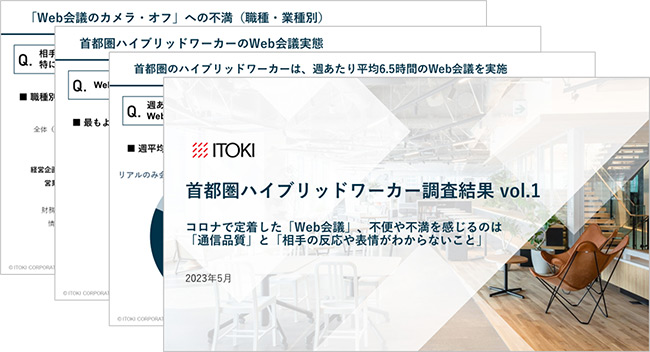
Research highlights
- Hybrid workers in the Tokyo metropolitan area conduct an average of 6.5 hours of web conferencing per week
- Regarding inconveniences and dissatisfaction with web conferencing, the first place was communication quality such as interruptions and delays (38.9%), and the second place was the other party's camera being off and not being able to see their reactions/expressions (32.6%).
- 62.1% of people generally turn off their cameras for reasons such as not showing their face.
- On the other hand, 57.1% of people feel inconvenienced or dissatisfied with the other person's camera being turned off, such as when they want to talk to the other person's face.
- Even if more people return to the office after the coronavirus, web conferencing will not disappear. In order for web conferencing to become a place for even higher quality discussions and conversations, it is necessary to resolve current issues, such as realizing "face-to-face communication," a need identified in this survey. .
*Click here to download detailed survey results
Survey results details
Hybrid workers in the Tokyo metropolitan area conduct an average of 6.5 hours of web conferencing per week
When we surveyed hybrid workers in the Tokyo metropolitan area about how many hours a week they held web conferences, we found that the average was 6.5 hours a week, and 82% of meetings were held over the web. Additionally, the most common web conferences attended in the past month were regular meetings at 77.2%.
*Regardless of where respondents participate, if even one person participates online, it will be considered a web conference.
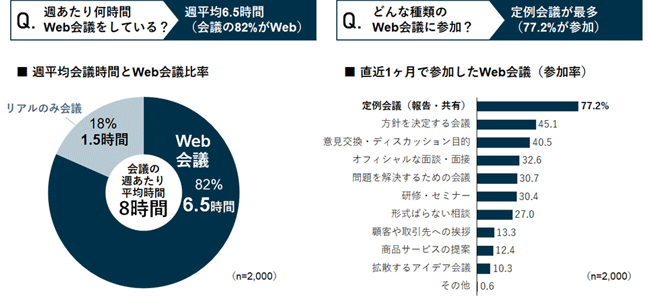
Regarding inconveniences and dissatisfaction with web conferencing, the first place was communication quality such as interruptions and delays (38.9%), and the second place was the other party's camera being off and not being able to see their reactions/expressions (32.6%).
When asked about the inconveniences and dissatisfaction with web conferencing, 38.9% of hybrid workers answered that ``communication quality such as interruptions and delays'' came first. 2nd place was ``I can't see the other party's reaction/expression because their camera is off (32.6%)'' and 4th place was ``I can't see the other party's reaction/expression when sharing materials (27.7%)''. The results showed that many people felt inconvenienced and dissatisfied with not being able to see facial expressions.
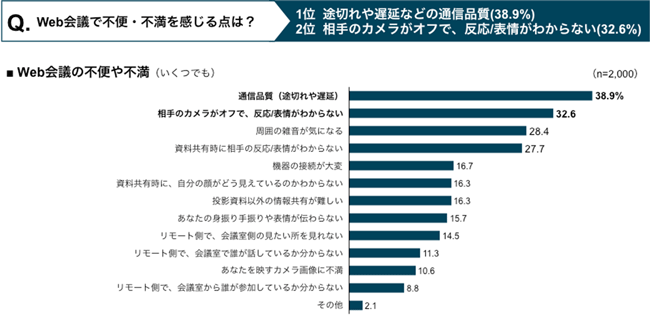
62.1% of people generally turn off their cameras because they don't have a problem with not showing their faces, etc.
When we surveyed people about their basic camera settings during web conferences, 19.6% of people said they always had their cameras off, and 42.5% said they usually turned their cameras off but sometimes turned them on. I found out that it is "basically turned off". In addition, the most common reason for turning off the camera was ``I don't have a problem with not showing my face,'' at 49.8%. When asked about inconveniences and dissatisfaction with web conferencing, 32.6% of people answered, "I can't see the other party's reactions/expressions because the other person's camera is off," which was second at 32.6%. It turns out that there is a gap between about 50% of people who think there is no problem.
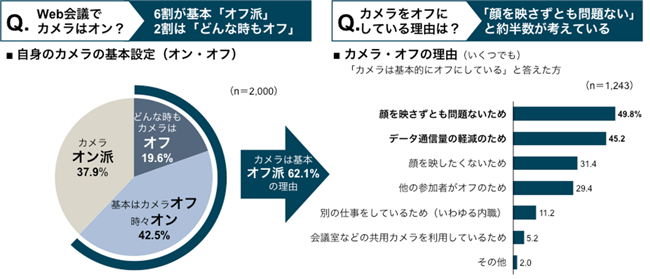
57.1% of people feel inconvenienced or dissatisfied with the other person's camera being turned off, such as wanting to see the other person's face when talking.
When asked about the inconvenience or dissatisfaction with having the camera turned off by participants other than themselves, 57.1% of people felt inconvenienced or dissatisfied. Also, the reasons for feeling inconvenient and dissatisfied were ``I want to talk to the other person face to face'' (26.6%), and 2nd place (26.5%) was ``The atmosphere of one-sided explanation makes it difficult to have a conversation or discussion'' (26.5%). ”, and 3rd place was ``I can't see the other person's expression so it's hard to speak (24.8%)''. These results revealed that there is a need for a web conferencing environment that allows participants to see each other's faces and speak naturally.
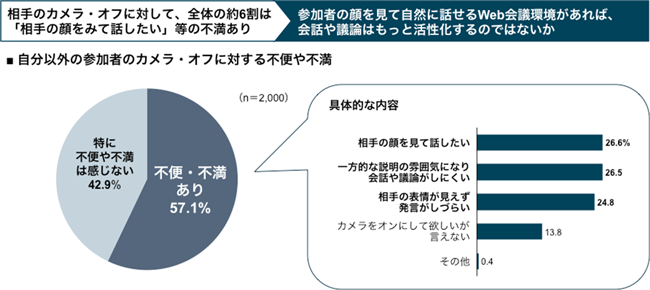
Summary: “Face-to-face communication” improves the quality of web conferences
The results of this survey revealed that web conferencing, which has become popular and established due to the coronavirus, has high needs but still has unresolved issues, such as "face-to-face communication." .
Although more and more people are returning to the office after the coronavirus, "web conferencing", which is a hybrid of real life and the web, will not disappear. It can now be said to be an indispensable communication tool for hybrid workers.
In order to further evolve web conferencing as a place for high-quality discussions and conversations, we need to improve the ease of speaking and create a sense of unity, such as by realizing "face-to-face communication," which will address the current issues. is required to be resolved.
*Click here to download detailed survey results
Survey overview
As more and more people return to the office after the coronavirus, we conducted a survey of hybrid workers at companies (100 or more employees) in the Tokyo metropolitan area to clarify the challenges of "web conferencing", which is a hybrid of real and online meetings. I did it.
| Survey name | “Metropolitan Area Hybrid workers Survey” |
|---|---|
| Survey target | Office workers who work at companies (100 or more employees) in Tokyo's 23 wards and who conduct hybrid work at least once a week (those who conduct web conferences) |
| Number of respondents | 2,000 people |
| Research method | internet research |
| Survey period | October 2022 |
- When posting content related to this release, please be sure to clearly indicate "Itoki research".
About Itoki's Workplace Business
Since its founding in 1890, ITOKI CORPORATION has upheld the mission statement of "We Design Tomorrow. We Design WORK-Style." and has supported the creation of a wide range of “Space," “Environment," and “Place" with a wide lineup of office furniture, logistics equipment, ICT and audiovisual equipment, and building materials and interior equipment.
After the coronavirus shock, we consider the entire working space to “Work Environment”," and in addition to products and services that create an environment where office workers can "work together," we are also providing "dispersion" of home furnishings to facilitate remote work and home learning We support the creation of a “Work Environment” in any space by providing a comprehensive range of products that support the working environment, as well as surveys and consulting services for companies' work style strategies and working environment improvements.
To this release
Contact information
株式会社イトーキ
スマートオフィス商品開発本部
調査分析部
TEL:03-6910-3910
press personnel
Contact information
株式会社イトーキ
広報IR部
TEL:03-6910-3910
- The information posted is current at the time of publication. Please note that the information may differ from the latest information.
